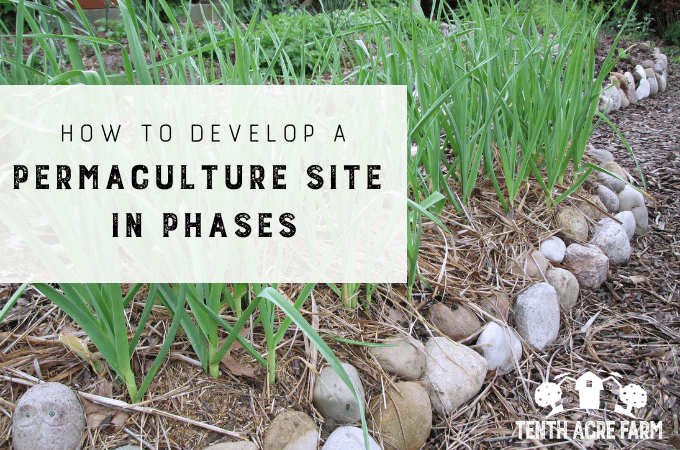How to Develop a Permaculture Site in Phases
Wondering how to do it all on your permaculture site? Learn how to break down all your dreams into bite-sized phases of development.


This page may contain affiliate links. Please read my disclosure for more info.
Creating Your Personalized Site Plan (You can do it!)
You have a lot of dreams and plans for your site, landscape, or garden. What should you do first, second, third? I know, I know, you ready to dig in. But before you do, let’s just make sure you have your priorities straight.
In permaculture design, we never, EVER skip the first and very important first step of making observations. Did you know there’s a specific set of questions to ask during this step to ensure you choose strategies that are in line with both your goals and the ecology of the land?
Indeed, you can download my free, 13-page worksheet, Making Observations, at the end of my article about how to use the power of observation in permaculture design. If you haven’t done that yet, start there!
Next, after making those passive observations, you’ll want to collect research about your site and plot it on physical maps of the property, which gives you a visual representation of all the data points that can affect design decisions. These are called active observations.
In my article 6 Maps for the Permaculture Site Design, I walk you through this process and lead you in creating a master plan for your homestead paradise. If you haven’t done that yet, start there!
In THIS article, you will work from your master plan to produce phases of development.
You need phases because you can’t make your wildest dream come true all at once! You’ll have to create a priority list; an order of operations.
Here is my Master Plan:


My master permaculture site plan
Planning Phases of Development
With your Master Plan in hand, you have a grand vision for your homestead. In my own Master Plan above, MY DREAM is to create:
Each of these dreams takes significant time, effort, and cost to complete. For this reason, the worst thing I could do is try my hand at all of them at the same time, willy-nilly!
Give each dream the proper attention so it is done well and functions efficiently within the whole system.
What we need is a realistic schedule that not only breaks down the whole list into manageable steps, but that also considers emergent and limiting factors to put the steps into the most efficient and logical ORDER.
Let’s dive in and see if we can make sense of this.
I’m going to walk you through five exercises that will help you prioritize your dreams and plan phases of development.
Want to grow fruits, vegetables, and herbs in your front yard landscape without sacrificing curb appeal? Check out my mini guide, The Permaculture Inspired Edible Landscape.
Does planning phases of development seem overwhelming? Here’s what to do.
#1: A certified permaculture designer can create a master plan for you, as well as flesh out your phases of development (order of operations). A designer takes your unique factors, goals, and dreams into consideration to help you shave years off of development.
Here’s more about hiring the right permaculture designer. It’s worth every penny, especially if you’ve done your homework to find the right designer for you.
#2: Also see my tips for starting a homestead without being overwhelmed!
#3: Check out my Permaculture Design Program, where you learn to be your own designer with my step-by-step, 6-part plan (and me by your side).
Now, on to the exercises for creating your own phases of development from your master plan.
Exercise #1: The BIG LIST
In this step, list all the MAJOR considerations within EACH of your dreams. Here’s an example of the difference between a major and minor consideration:
Major Consideration: Having a water source for your garden
Minor Consideration: What you want to plant (That part comes later!)
For example, for my Vegetable Garden Dream, I must consider the following major tasks/challenges:
- Water: Bury the downspouts and direct them to the garden; There is no spigot near the garden.
- Storage: There is no storage for supplies or materials near the garden.
- Garden Design: Plan layout of permanent beds.
- Bed Development: Import organic matter and materials for raised beds.
- Fencing: Deer, raccoons, and many more critters from the woods will be vying for my delicious crops!
I’ve put the above tasks and challenges into the most logical order I can think of in this moment. I don’t want to plant a garden before I have a water source or before I have a place to store equipment and materials.
I also don’t want to plant anything before I’ve put up proper fencing. Rather than plant a garden and then curse the deer for eating it, I will take the proper action before growing any crops. (Avoid time and money wasters whenever possible)!


Peppers harvested from my garden
Note:
Phases of development don’t have to be super-productive phases. The permaculture design process includes both passive observation and active interaction.
We developed the original Tenth Acre Farm over 8 years. There was very little productivity in those first couple of years, but the end result was an amazingly beautiful, efficient, and productive micro-farm.
Create Your Own Individualized Permaculture Design (with me by your side)!
Tired of generic permaculture design advice that you can’t apply to your specific goals? If so, check out my Permaculture Design Program and get the step-by-step tools and support needed to create and implement your own permaculture design.
Exercise #2: EMERGENT AND LIMITING FACTORS
In this step, you will go deeper into what factors may affect the ORDER in which you complete your phases of development.
#1: Emergent Factors are emergency-type tasks to complete right away.
Example 1: Our basement floods when it rains because the downspouts are improperly channeled and the landscaping around the house is improperly graded.
I’ve moved ‘properly channel downspouts toward future growing areas‘ to the top of our task list because it solves an emergent issue. I’ve also added ‘regrade and redesign formal landscape‘ to the top of the task list for the same reason.
One emergent factor can create a cascade of other tasks that move higher on the list.
#2: Limiting Factors are challenges that might prevent certain tasks from being completed in a certain order.
Some examples are:
- Seasonal: Tasks that can only be completed during a certain time of year
- Financial: Tasks that have to wait until money is saved
- Labor: Tasks that must be completed by skilled professionals or that have to wait until helpers are available
- Resource: Tasks that must wait until resources/tools/materials are purchased/collected/delivered
Example: My Vegetable Garden Dream requires that we build a garden shed for tool/material storage, which must also include a spigot for watering (running a water line as well as electric). This will be time-consuming (and perhaps expensive) to build.
When I factor in the additional costs of garden bed development and fencing, the vegetable garden project as a whole moves lower down on the list while we save money for it.


Fresh basil from the garden
Exercise #3: SMALL CHANGES WITH AN IMMEDIATE BENEFIT
Are there any tasks that you can do before others, are easy to complete, and would create significant momentum? In permaculture, this is referred to as ‘the least change for the greatest effect’. That is to say, we want small and easy wins to motivate and encourage us to keep going (low hanging fruit).
It can be beneficial to work outward from your zone 1 (see 6 Maps for your Permaculture Homestead for an explanation of zones) or other already managed areas.
Example: Regrading and redesigning my formal landscape (zone 1):
- allows us to bury downspouts and properly direct them toward garden areas (passive irrigation)
- eliminates basement flooding
- improves biodiversity with more flowering and native plants (good for future gardens)
- improves curb appeal and general enjoyment of outdoor sitting areas
- reduces formal landscape by 685 square feet, making it more manageable so there is more time for food-growing projects
Now obviously the formal landscape is not useful in the sense that it produces a lot of food. But it does help us knock out several challenges at once, giving us momentum, and takes away the nagging in the back of my mind about the jungle growing by the front door.
This exercise ultimately helps to relieve worry of all there is to do and starts momentum in the right direction. When we have a clear plan of action, we can simply focus on the next thing on the list, and put all our energy into it.
Exercise #4: The TIMELINE
For this exercise, it can be helpful to physically put your major tasks in the most efficient/logical order. I like to use sticky notes on a whiteboard, other people like to use index cards, and still others like to use a spreadsheet on the computer. Choose what works for you.
Here’s what my timeline looks like when I put all of the major tasks into order, considering my dreams, emergent/limiting factors, and easy wins:


My Dream Timeline before I break it down into phases of implementation.
Exercise #5: PHASES OF DEVELOPMENT
Now, take your timeline of tasks and divide them into phases of development.
I like to think of phases in terms of YEARS.
In this case, when I take the 25 tasks on my timeline above and divide them into phases, here is what I get:


Phases of Development for us here at @ Twisted Creek
Phases of development allow you to have a stopping point. To be sure, we homesteaders could easily to-do-list ourselves right to our grave, and life is definitely more than a to-do list!
At the end of a phase, stop to enjoy and appreciate what you’ve created. Celebrate your hard work and commitment to work done well.
The cool thing about doing this with sticky notes on a whiteboard is that if something doesn’t get done during the prescribed phase (year), it can simply be moved to the next phase (year) with an adjustment of sticky notes.
Our Phase One here at Tenth Acre Farm @ Twisted Creek:
As you can see in my Phases of Development photo above, we’ve already checked a few items off our Year One list and have gained momentum.
We brought in a professional tree service to take down the tall trees that were too close to the house. They chipped up the small stuff, which is a great beginning for the food forest. They also left the big stuff, and we’ll slowly turn it into firewood and lumber.
Once the heavy machinery was gone, we buried the downspouts, directing them to the garden areas, and regraded the formal landscaping.
I’ve redesigned the landscape, and I’m excited to have 685 square feet LESS of landscaping areas to manage. The remaining landscaped areas will be more beautiful, more biodiverse, and easier to maintain.
I can’t stop smiling as we head toward food forest development right on time!
Summary for Planning Phases of Development
Developing a homestead is an exciting and rewarding venture, but it can be overwhelming to figure out how to accomplish all there is to do.
That’s why phases of development help you break down all you want to accomplish into manageable tasks and put them into a logical and efficient order.
References
Have you used phases of development to pace your way through completing a dream?
READ NEXT:









